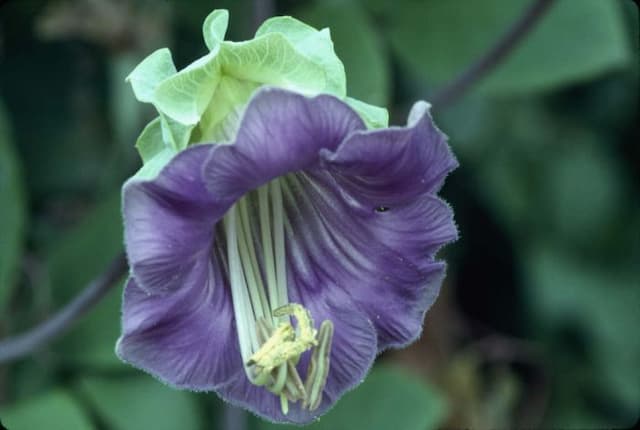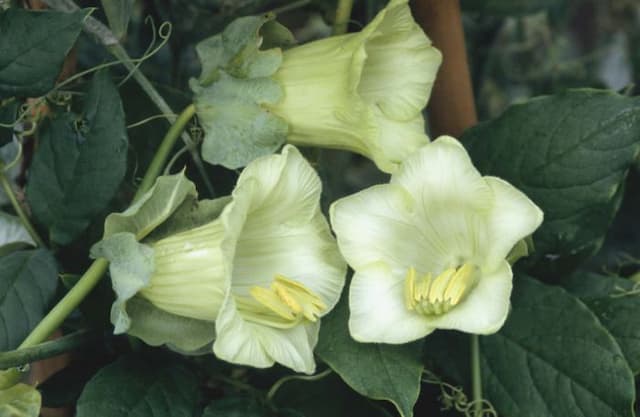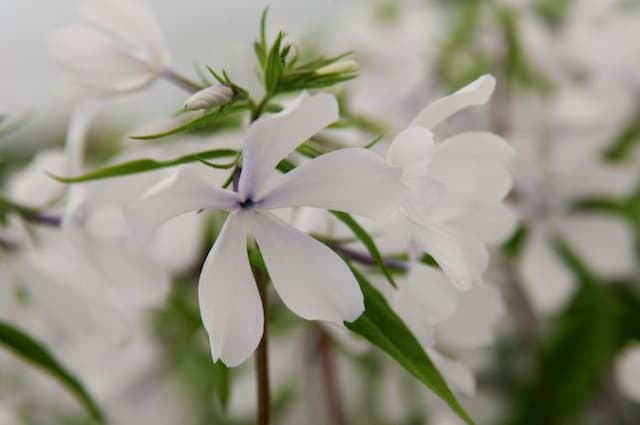Meadow phlox Phlox maculata 'Natascha'

ABOUT
The Phlox maculata 'Natascha' is a striking perennial plant known for its distinctive variegated appearance. It features a lush foliage that is bright green in color with a pleasing texture. What makes 'Natascha' stand out are the contrasting white stripes that beautifully streak across the leaves, offering a striking visual contrast to the greenery. Come blooming season, 'Natascha' produces clusters of star-shaped flowers that have a captivating pink hue lined with white edges. These flowers are not only visually appealing but also emit a sweet fragrance that can be quite alluring in a garden setting. The blossoms are densely packed in rounded clusters, which sit attractively atop the upright and sturdy stems of the plant, creating a lovely display of color and form. Overall, the variegated foliage and bicolored pink and white flowers make Phlox maculata 'Natascha' a delightful addition to any garden, offering a continuous and vibrant display through its blooming period.
About this plant
 Names
NamesFamily
Polemoniaceae.
Synonyms
Meadow Phlox, Wild Sweet William, Spotted Phlox.
Common names
Phlox maculata.
 Toxicity
ToxicityTo humans
The common name for Phlox maculata 'Natascha' is meadow phlox. Meadow phlox is not generally known to be toxic to humans. However, it's always advisable to prevent ingestion of ornamental plants as they can cause digestive discomfort or an allergic reaction in sensitive individuals.
To pets
Meadow phlox is not typically toxic to pets. It is not listed among plants known to be poisonous to cats, dogs, or other domestic animals. As with humans, it is still best to discourage pets from ingesting plants as they could cause an upset stomach or an unexpected allergic reaction.
 Characteristics
CharacteristicsLife cycle
Perennials
Foliage type
Deciduous
Color of leaves
Green
Flower color
Pink
Height
2-3 feet (60-90 cm)
Spread
1-2 feet (30-60 cm)
Plant type
Herb
Hardiness zones
4
Native area
North America
Benefits
 General Benefits
General Benefits- Attracts Pollinators: Phlox maculata 'Natascha' is known to attract bees, butterflies, and other beneficial insects, supporting biodiversity.
- Easy to Grow: This plant is relatively low maintenance and can thrive with minimal care once established.
- Colorful Blooms: It produces striking pink and white striped flowers that add vibrant color to gardens or landscapes.
- Pest Resistance: The species generally has good resistance to common garden pests, reducing the need for chemical treatments.
- Mildew Resistance: 'Natascha' displays a resistance to powdery mildew, a common problem in phlox species.
- Long Blooming Period: The flowering season is long, often from mid-summer to early fall, providing extended visual interest.
- Cut Flowers: The flowers are suitable for cutting and can be used in floral arrangements.
- Wildlife Friendly: It provides nectar for pollinators, and its presence can help sustain local wildlife populations.
- Naturalizing: It can spread under the right conditions, filling in garden spaces and creating a fuller look.
- Aesthetic Versatility: The plant’s form and color make it suitable for various garden styles, including cottage and wildflower gardens.
- Suitable for Borders: They are ideal for garden borders, creating defined lines and adding structure to garden design.
- Drought Tolerance: Once established, it can tolerate periods of drought, making it suitable for drier climates.
 Medical Properties
Medical PropertiesThis plant is not used for medical purposes.
 Air-purifying Qualities
Air-purifying QualitiesThis plant is not specifically known for air purifying qualities.
 Other Uses
Other Uses- Phlox 'Natascha' can be used as a natural dye, where the flowers give a subtle shade to fabrics or yarns.
- The plant can serve as a food source for rabbits and deer, which may graze on its leaves and stems in a garden setting.
- Insects such as butterflies and hummingbirds benefit from Phlox 'Natascha' as it provides them with nectar during the blooming season.
- Phlox 'Natascha' stalks can be used as support structures for weaker, climbing plants or vines within a garden.
- The plant's dense growth habit allows it to be used as a natural ground cover to help suppress weeds and protect soil.
- Phlox 'Natascha's vibrant flowering can be used for color-themed garden designs, creating visual interest and focal points.
- It can act as an indicator plant for gardeners; spotting mildew on its leaves can alert to potential problems with air circulation or moisture levels.
- In educational settings, Phlox 'Natascha' can be used to teach students about pollination and the life cycle of plants.
- The flowers from Phlox 'Natascha' can be pressed and used in crafts such as bookmark making or pressed flower art.
- When planted en masse, Phlox 'Natascha' can be used to stabilize soil on slight slopes, preventing erosion and runoff.
Interesting Facts
 Feng Shui
Feng ShuiThe Wild Sweet William is not used in Feng Shui practice.
 Zodiac Sign Compitability
Zodiac Sign CompitabilityThe Wild Sweet William is not used in astrology practice.
 Plant Symbolism
Plant Symbolism- Agreement: Phlox, in general, is often associated with the notion of agreement or unity. The name 'Natascha' suggests a personal touch, which may symbolize a personal pact or agreement.
- Harmony: The clustered growth of phlox flowers symbolizes living in harmony. 'Natascha' with its unique patterning could emphasize the beauty of different elements coexisting together.
- Proposal: Phloxes were historically used to symbolize a proposal of marriage or a romantic offer, reflecting the flowers' romanticized appearance.
- Sweet Dreams: With its beautiful and clustered blooms, 'Natascha' may represent the wish for pleasant dreams or a symbol of hope.
 Water
WaterMeadow Phlox should be watered regularly, especially during dry periods, to maintain a consistent level of moisture without waterlogging the soil. Aim to water deeply once a week, providing about one gallon of water per plant, ensuring the water reaches the root zone. During hot or windy weather, you may need to water more frequently, while in cooler or rainy conditions, water less often. It's vital to avoid overhead watering to reduce the risk of fungal diseases and to water early in the morning to allow foliage to dry before evening.
 Light
LightMeadow Phlox thrives in full sun to partial shade, with a preference for bright, indirect light for most of the day. The best spot for this plant would be an area that receives at least six hours of sunlight daily, but is protected from the harsh afternoon sun that could scorch the foliage, especially in hotter climates.
 Temperature
TemperatureMeadow Phlox is hardy and can tolerate a range of temperatures, but it grows best in conditions between 60°F and 85°F. It can survive minimum temperatures down to about -30°F, making it suitable for many temperate regions. Avoid exposing Meadow Phlox to prolonged temperatures above 90°F as it may stress the plant.
 Pruning
PruningPruning Meadow Phlox is essential to encourage bushier growth and better air circulation, which helps prevent mildew and other fungal diseases. It's best to prune or deadhead spent flowers regularly to promote continuous blooming. After flowering, cut back the stems to maintain a neat shape and remove any dead or diseased foliage. The best time for a more thorough pruning is in late winter or early spring, just before new growth begins.
 Cleaning
CleaningAs needed
 Soil
SoilMeadow Phlox prefers moist, well-draining soil with a pH of about 6.5 to 7.0. A good soil mix might contain loamy garden soil, compost, and peat moss to retain moisture while ensuring drainage. Ensure regular enrichment with organic matter to support its growth.
 Repotting
RepottingMeadow Phlox does not typically require frequent repotting; it is usually repotted every 2-3 years or when it outgrows its current container. Spring is the best time to repot this perennial to minimize stress and allow rapid root development.
 Humidity & Misting
Humidity & MistingMeadow Phlox thrives in average garden humidity levels. While this plant does not have specific humidity requirements, it benefits from moderate humidity, especially during prolonged dry periods.
 Suitable locations
Suitable locationsIndoor
Ensure bright light, consistent moisture, and good air flow.
Outdoor
Plant in sun to partial shade, enrich soil, maintain moisture.
Hardiness zone
3-8 USDA
 Life cycle
Life cyclePhlox maculata 'Natascha', commonly known as Meadow Phlox or Wild Sweet William, begins its life cycle when seeds are sown after the last frost in spring, germinating in warm, moist soil. Once germinated, seedlings will emerge and begin to establish a small rosette of leaves; with proper sunlight, water, and nutrients, these seedlings will grow into mature plants. The mature Meadow Phlox typically forms a clump of erect stems with lance-shaped leaves, reaching up to 2-4 feet in height. Flowering occurs in mid to late summer, presenting clusters of fragrant, tubular flowers striped with pink and white hues, attracting pollinators such as butterflies and hummingbirds. After blooming, the plant sets seed, which can be dispersed by wind or wildlife, completing the reproductive cycle. In autumn, the Meadow Phlox will die back to the ground with the onset of cold weather, surviving winter as a dormant root system, ready to regrow in the following spring.
 Propogation
PropogationPropogation time
Spring to Summer
Phlox maculata 'Natascha', commonly known as Meadow Phlox, is often propagated by division, which is the most popular method. This typically takes place in early spring or early fall to allow the plant time to establish before the extremes of summer heat or winter cold. To propagate by division, the gardener should gently dig up an established clump of Meadow Phlox and carefully separate it into smaller sections, ensuring each section has a good amount of roots. These sections can then be replanted at the same depth they were growing previously, spaced about 12 to 18 inches (approximately 30 to 45 centimeters) apart to provide adequate room for growth. Watering the newly planted divisions thoroughly helps establish them in their new location.









